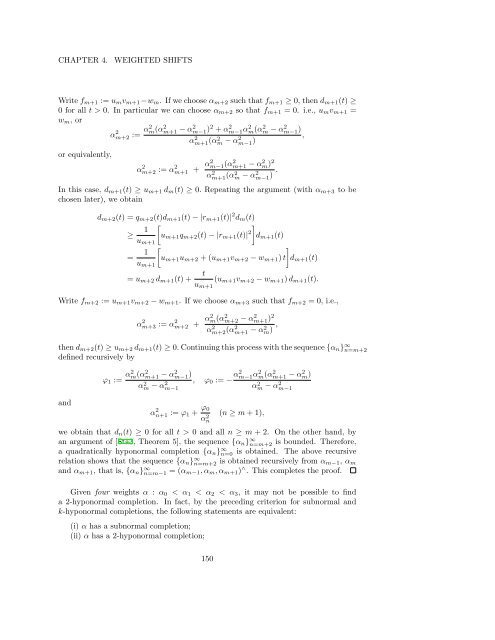Woo Young Lee Lecture Notes on Operator Theory
Woo Young Lee Lecture Notes on Operator Theory
Woo Young Lee Lecture Notes on Operator Theory
Create successful ePaper yourself
Turn your PDF publications into a flip-book with our unique Google optimized e-Paper software.
CHAPTER 4.<br />
WEIGHTED SHIFTS<br />
Write f m+1 := u m v m+1 −w m . If we choose α m+2 such that f m+1 ≥ 0, then d m+1 (t) ≥<br />
0 for all t > 0. In particular we can choose α m+2 so that f m+1 = 0. i.e., u m v m+1 =<br />
w m , or<br />
α 2 m+2 := α2 m(α 2 m+1 − α 2 m−1) 2 + α 2 m−1α 2 m(α 2 m − α 2 m−1)<br />
α 2 m+1 (α2 m − α 2 m−1 ) ,<br />
or equivalently,<br />
α 2 m+2 := α 2 m+1 + α2 m−1(α 2 m+1 − α 2 m) 2<br />
α 2 m+1 (α2 m − α 2 m−1 ) .<br />
In this case, d m+1 (t) ≥ u m+1 d m (t) ≥ 0. Repeating the argument (with α m+3 to be<br />
chosen later), we obtain<br />
d m+2 (t) = q m+2 (t)d m+1 (t) − |r m+1 (t)| 2 d m (t)<br />
≥ 1 [<br />
u m+1 q m+2 (t) − |r m+1 (t)|<br />
]d 2 m+1 (t)<br />
u m+1<br />
= 1 [<br />
]<br />
u m+1 u m+2 + (u m+1 v m+2 − w m+1 ) t d m+1 (t)<br />
u m+1<br />
= u m+2 d m+1 (t) + t<br />
u m+1<br />
(u m+1 v m+2 − w m+1 ) d m+1 (t).<br />
Write f m+2 := u m+1 v m+2 − w m+1 . If we choose α m+3 such that f m+2 = 0, i.e.,<br />
α 2 m+3 := α 2 m+2 + α2 m(α 2 m+2 − α 2 m+1) 2<br />
α 2 m+2 (α2 m+1 − α2 m) ,<br />
then d m+2 (t) ≥ u m+2 d m+1 (t) ≥ 0. C<strong>on</strong>tinuing this process with the sequence {α n } ∞ n=m+2<br />
defined recursively by<br />
and<br />
φ 1 := α2 m(αm+1 2 − αm−1)<br />
2<br />
αm 2 − αm−1<br />
2 , φ 0 := − α2 m−1αm(α 2 m+1 2 − αm)<br />
2<br />
αm 2 − αm−1<br />
2<br />
α 2 n+1 := φ 1 + φ 0<br />
α 2 n<br />
(n ≥ m + 1),<br />
we obtain that d n (t) ≥ 0 for all t > 0 and all n ≥ m + 2. On the other hand, by<br />
an argument of [Sta3, Theorem 5], the sequence {α n } ∞ n=m+2 is bounded. Therefore,<br />
a quadratically hyp<strong>on</strong>ormal completi<strong>on</strong> {α n } ∞ n=0 is obtained. The above recursive<br />
relati<strong>on</strong> shows that the sequence {α n } ∞ n=m+2 is obtained recursively from α m−1 , α m<br />
and α m+1 , that is, {α n } ∞ n=m−1 = (α m−1 , α m , α m+1 ) ∧ . This completes the proof.<br />
Given four weights α : α 0 < α 1 < α 2 < α 3 , it may not be possible to find<br />
a 2-hyp<strong>on</strong>ormal completi<strong>on</strong>. In fact, by the preceding criteri<strong>on</strong> for subnormal and<br />
k-hyp<strong>on</strong>ormal completi<strong>on</strong>s, the following statements are equivalent:<br />
(i) α has a subnormal completi<strong>on</strong>;<br />
(ii) α has a 2-hyp<strong>on</strong>ormal completi<strong>on</strong>;<br />
150













